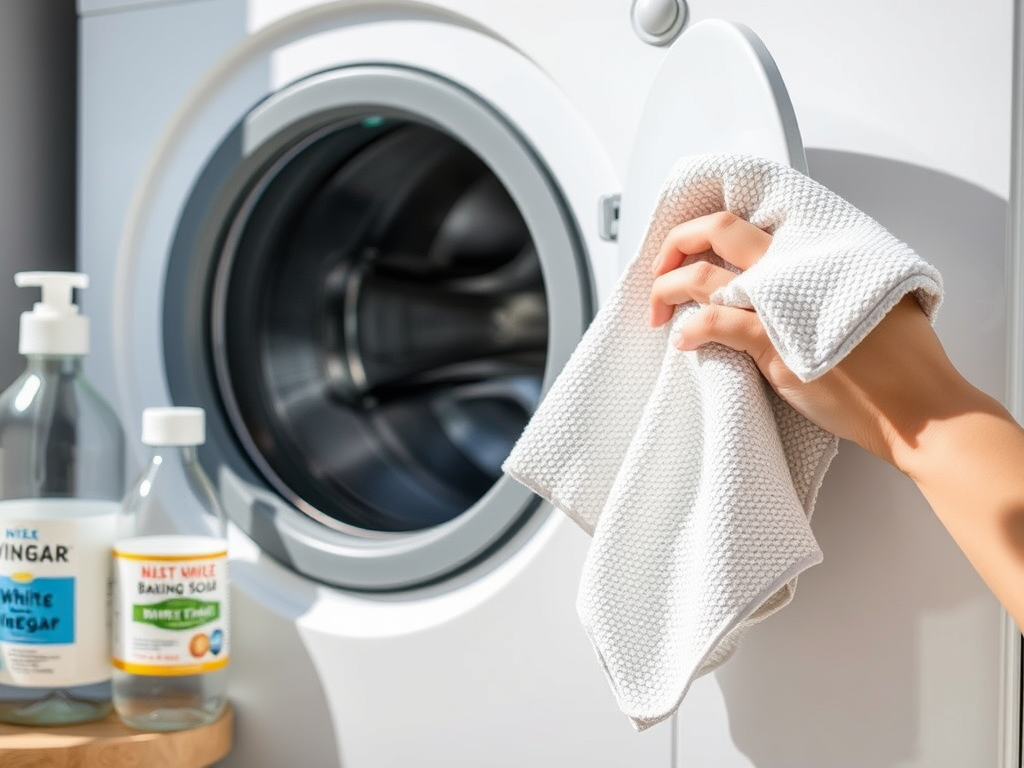Even though it’s a cleaning machine, your washer can become a breeding ground for mold, mildew, and bacteria. If your clothes come out smelling funky — or you notice a sour, musty odor — it’s time for a deep clean.
Here are the most common reasons for the smell:
- 🧼 Built-up detergent and softener residue in the drum or dispenser
- 🌫️ Mold and mildew hiding in the rubber door seal (especially in front-loaders)
- 🧵 Trapped debris like hair, lint, and fabric fibers in filters and hoses
- 🧊 Frequent cold washes, which don’t kill bacteria effectively
🧂 What You’ll Need:
- White vinegar (2 cups)
- Baking soda (½ cup)
- Microfiber cloth
- Old toothbrush
- Optional: Lemon essential oil or hydrogen peroxide
🧽 How to Clean a Smelly Washing Machine – Step-by-Step
1️⃣ Clean the Door Seal
Gently pull back the rubber seal around the door. You’ll often find grime, hair, and even mold here. Soak a cloth in white vinegar or hydrogen peroxide and wipe thoroughly. Use an old toothbrush for tight spots.
2️⃣ Wash the Detergent Drawer
Remove the detergent drawer and scrub it with hot water and a toothbrush. Detergent residue builds up over time, creating a perfect environment for mildew.
3️⃣ Run a Hot Cycle with Vinegar
Pour 2 cups of white vinegar directly into the drum (no laundry!) and run your hottest wash cycle. Vinegar disinfects and breaks down grime.
4️⃣ Add Baking Soda
After the vinegar cycle finishes, sprinkle ½ cup of baking soda into the drum. Run a short, hot rinse cycle to neutralize odors and lift remaining buildup.
5️⃣ Wipe Everything Dry
Once the cycles are done, dry the inside of the drum, door, and seal with a clean microfiber cloth. Leave the door open to air out completely.
🌿 Optional: Add a Natural Scent
Want a fresher finish? Add 5–10 drops of lemon essential oil to your final wipe-down or directly into the baking soda before the rinse cycle.
♻️ How Often Should You Clean It?
- 🧼 Deep clean: Once a month
- 🧽 Quick wipe: After every few washes
- 🚪 Leave the door open after each use to prevent moisture buildup
- 🧵 Clean filters monthly or as recommended by your washer’s manual
✅ Bonus: Prevention Tips
- Use less detergent — more isn’t better! Excess soap can cling to the drum and trap odors.
- Always remove wet laundry right after a wash.
- Avoid frequent cold washes; mix in hot washes regularly.
- Clean the lint trap and drain filter if your machine has one.
- Use high-efficiency (HE) detergents if your washer requires them.
🙋♀️ FAQ – Washing Machine Odors
Q: Can I use bleach instead of vinegar?
A: You can, but vinegar is safer for the environment and your health. Avoid mixing bleach and vinegar together — it’s dangerous!
Q: What if my machine still smells after cleaning?
A: Check the drain filter and internal hoses. If the smell persists, mold may be deeper in the system and require professional cleaning.
Q: Is vinegar safe for all washing machines?
A: Yes! White vinegar is safe for most washers — both top and front loaders — and won’t harm the drum or plumbing.
Q: How do I clean a top-loading machine?
A: Use the same method: vinegar in a hot wash, then baking soda. Scrub the lid and agitator, and wipe dry.
🔗 Related Articles You Might Like:
- 🧼 How to Clean an Oven Without Chemicals
- 🍋 How to Clean a Microwave with Lemon
- 🛁 How to Remove Mold in the Shower
💬 Final Thoughts
A smelly washer doesn’t mean it’s broken — it just needs a little love! With simple natural ingredients and a monthly cleaning routine, you can enjoy fresh-smelling laundry and a sparkling clean machine every time.
Ready to give your washing machine a spa day? 🧼🌼

Leave a Reply